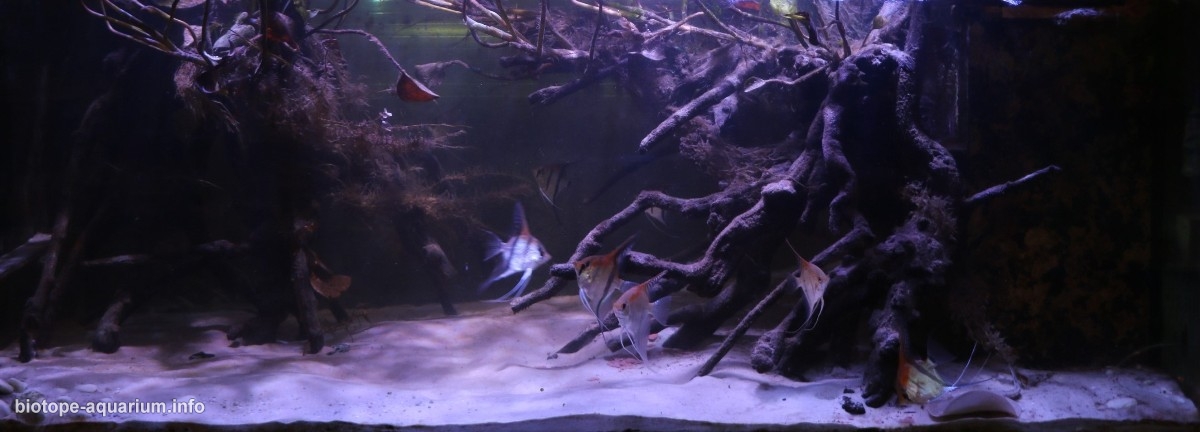Flooded forest of Lago Grande do Rio Manacapuru, Amazonas, Brazil
85th place in Biotope Aquarium Design Contest 2019
Italy. Cristian Ghia

Volume: 768 L
Dimensions: tank 160x60x80 cm, sump 100x40x60 cm
List of fishes: Pterophyllum sp. “Lago Grande do Rio Manacapuru” (probably P. scalare), Potamotrygon motoro “pattern and color : Rio Manacapuru”
List of plants: Eichhornia azurea, Philodendron cf. brasiliensis
Description of decorations: Amazon drift wood / mix of white sand (powder, micron, 1-2mm).
Description of equipment: sump, with 2 aqarium pumps NEWA Jet 3000. Ceiling 4 Zetlight UFO (Scheduled to recreate sunrise / sunset ; cloud passagge and thunderstorms twice a week. The ceiling light can be adjusted by varying their color and intensity during the day. So as the recreate the typical day inthe Amazon River Basin as precisely as possible.)
Water parameters: Ph 6.8/6.9 (variation day/night)
kh 5dH°
gh 8dH°
376,5 microsiemens
NO2 0mgl
NO3 0mgl
Additional info: Filtering is done by phytodepuration by Philodendron and Eichhornia. In addition to the mechanical / biological sponge filter in the sump. Weekly water change 10/20%
INFORMATION ABOUT BIOTOPE
Description of the area surrounding the biotope: Lago Grande do Rio Manacapuru. Coordinates in DMS format: -3.058130, -61.472873. Country: Brasil. Location: Amazonas, Region Norte de Brasil. Altitude: 9mt. It is a type H Lake (Hydrographic Lake), that is, it is a basin that is part of a hydrographic system like that of the Amazon (which also includes the Rio Manacapuru). The Rio Manacapuru is one of those that has several Hydrographic Lakes during its path to the junction with the Amazon River in the vicinity of Lake Cabaliana / Lake Miriti. THERE ARE the Lago Grande do Rio Manacapuru.
Description of the underwater landscape of the biotope: Water chemistry: Black water with a light sandy bottom (pinkish white). “black” water but with the presence of suspended clays. The “dark” color becomes like white water is linked in particular to the backwash formed by the floods I am trying to reproduce.
The PH is acid tending to neutral (6.8 PH); with 376 microsiemens conductivity. Presence of trunks and branches, foliage on the bottom and small branches which, when decomposed, make the light-colored backdrop dirty with a beautiful brown color.
Description of the parameters of the habitat: The Biotope I recreatedhas chemical values that vary during the seasons . The exact value is difficult to estabilish even if data area found in the area by reserchers, fishermen. In the loops of the Lake where there is the presence of Pterophyllum, the Ph 6or 6.8 depending on the percentage of oxygen present and season.
List of fishes and invertebrates occurring in the nature biotope: Colossoma macropodum ; Cichla sp. ; Mylossoma duriventre; Astronotus crassipinis ; Prochilodus nigricans ; Osteoglossum bicirrhosum ; Brycon amazonicus ; Pygocentrus nettereri ; Piaractus bracypomus ; Satanoperca jurupari ; Heros sp. ; Mesonauta sp. ; Symphysodon aequifasciatus haraldi ; Sorubim lima ; Pterophyllum scalare ; Pterophyllum leopoldi and many other
List of plants found in the nature biotope: Plants are present but not all over the Lake but only in areas. WHERE it usually dominates only one species, maximum two.
Eichhornia crassipes
Eichhornia azurea
Eichhornia diversifolia
Cabomba furcata
Echinodorus grisebachii amazonicus / bleherae (in its Biotope it is present with single plants)
Helanthium bolivianum “angustifolius”
Maclovian lilaeopsis
Nymphaea sp. (it is a water lily with red leaves that creates carpets that unfortunately have not yet managed to classify)
Paspalum repens
Threats to the ecology: –
Sources of information:
INFO from local fishermen , video in the web , biotope book .
IMPORTANT INFO found by Dr. Sergio Roberto Moraes Rebelo of (Universidade Federal do Amazonas)
IMPORTANT INFO found by Dr. Maria Gercilia Mota Soares of INPA (Instituto Nacional de Pesquisas da Amazonia)
Both participated in a census and research study:
NEOTROPIC BIOTE
(DEPARTMENT OF BIOLOGIA VEGETAL – INSTITUTO DE BIOLOGIA
– UNICAMP CP6109, 13083-970 – Campinas / SP)
Biota Neotrop. Vol.10 no.3 Campinas July / Sept. 2010
FISH DIET FROM MANACAPURU BIG LAKE COMPLEX (AMAZON): a approach starting from the traditional knowledge
